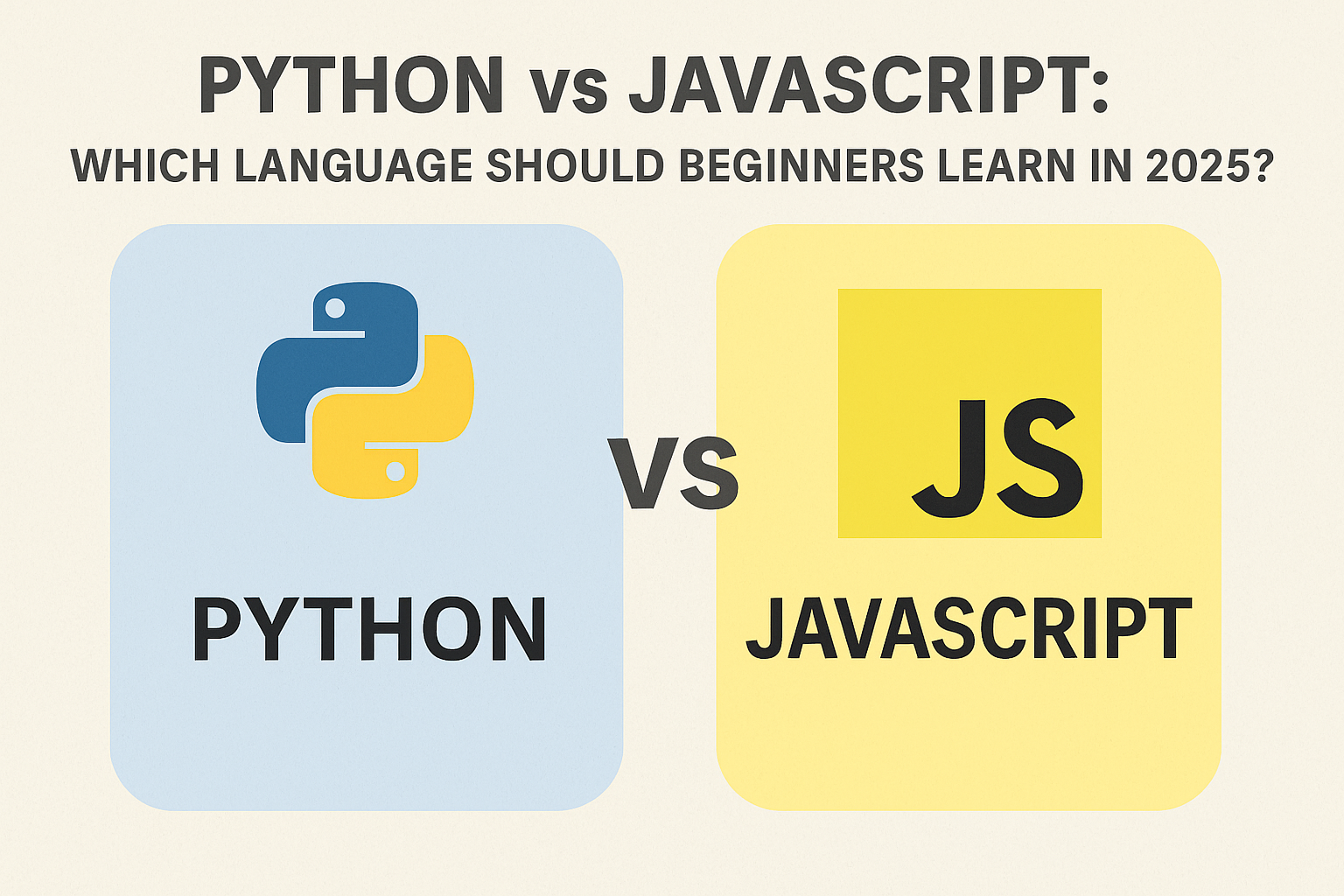
Introduction
Choosing your first programming language can shape your career, projects, and even income. In 2025, the debate is still strong: Python or JavaScript?
Both languages dominate different areas of tech:
- Python powers AI, data science, automation, and backend development.
- JavaScript remains the king of web development and full-stack engineering.
If you’re a student, beginner, or career changer, this guide will help you decide. We’ll explore industry demand, salaries, learning curves, project paths, and provide step-by-step roadmaps — from basic to pro — tailored to your goals.
Python vs JavaScript: Real-World Comparison
1. Popularity and Demand
- According to the TIOBE Index 2025, Python is ranked #1, while JavaScript consistently stays in the top 5.
- In the Stack Overflow Developer Survey 2024, JavaScript was the most commonly used language (63%), while Python was the most desired for learning (43%).
- Verdict: Python is preferred for learning & innovation, while JavaScript dominates practical usage in web.
2. Learning Curve
- Python: Often called “pseudo-English,” Python syntax is clean and beginner-friendly. Example:
for i in range(5):
print("Hello, World!")
- JavaScript: Slightly more complex due to web concepts (DOM, async). Example:
for (let i = 0; i < 5; i++) {
console.log("Hello, World!");
}
- Verdict: Beginners usually find Python easier to start with.
3. Ecosystem and Libraries
- Python: Best for AI, ML, and Data Science. Libraries include NumPy, Pandas, TensorFlow, and Flask/Django for backend.
- JavaScript: Dominates web. React, Angular, Vue for front-end; Node.js/Express for back-end. Full-stack apps rely on JS.
- Verdict: Choose Python for data-driven roles, JavaScript for web & app development.
4. Job Market & Salaries (2025)
- Python developer salary (India): ₹6–12 LPA (entry), ₹18+ LPA (senior in ML/AI).
- JavaScript/React/Node developer salary (India): ₹5–10 LPA (entry), ₹15+ LPA (senior full-stack).
- US Market:
- Python (Data roles) → Avg $110,000/year.
- JavaScript (Web roles) → Avg $105,000/year.
- Verdict: Both are lucrative. Python slightly leads in AI/ML salaries; JS dominates web dev hiring volume.
5. Community and Support
- Python: Backed by academic institutions, researchers, and data scientists. Huge learning resources.
- JavaScript: Massive open-source community, strongest web support, and endless Stack Overflow answers.
- Verdict: Both have unmatched support — but Python wins for research, JS wins for practical dev help.
Step-by-Step Roadmaps (Basic → Pro)
Variation A — Student / Absolute Beginner (Python)
- Week 1–2: Install Python, learn variables, loops, and conditionals.
- Week 3–4: Functions, lists, dicts, tuples. Solve 30+ coding exercises.
- Week 5–6: Learn file handling, error handling, and modules.
- Week 7–8: Explore Pandas & Matplotlib — build a small data analysis project.
- Week 9–12: Choose a specialization: Flask/Django (web) or ML (scikit-learn).
- Pro Tip: Join Kaggle or build an online portfolio with Jupyter notebooks.
Variation B — Student / Absolute Beginner (JavaScript)
- Week 1–2: Learn HTML & CSS basics.
- Week 3–4: Variables, loops, functions in JS. Build a quiz app.
- Week 5–6: DOM manipulation (events, styles, API fetch).
- Week 7–8: Learn ES6 features (arrow functions, promises, async/await).
- Week 9–12: Learn React basics → build a small to-do or notes app.
- Pro Tip: Deploy your project on Netlify/Vercel to show employers.
Variation C — Career Changer (Fast Track)
- Python Path:
- Focus on Python + Pandas + SQL → land data analyst role in 4–6 months.
- Add ML (scikit-learn, TensorFlow) for data scientist roles.
- JavaScript Path:
- Learn HTML, CSS, and JS basics in 1 month.
- Move to React + Node.js stack. Build 3–4 full-stack projects.
- Specialize in either frontend (React) or backend (Node).
Pro Tip: For career switchers, projects matter more than certificates. Build, deploy, and showcase on GitHub.
Variation D — Pro-Level Developer (Advanced)
- Python Pros: Move into AI/ML, automation, scientific computing, backend scaling.
- JavaScript Pros: Specialize in React Native (mobile), Next.js (SSR apps), or Node.js microservices.
Pro Tip: At pro level, your skill isn’t the language, it’s your ability to architect scalable apps and collaborate with teams.
Progressive Project Ideas
Python Projects:
- Beginner: Calculator CLI, Weather Scraper.
- Intermediate: Flask Blog, Data Dashboard with Pandas.
- Advanced: ML-powered Sentiment Analyzer.
JavaScript Projects:
- Beginner: To-do app with DOM.
- Intermediate: Weather App using Fetch API.
- Advanced: Full-stack eCommerce app (React + Node + MongoDB).
Frequently Asked Questions (FAQs)
1. Which is easier: Python or JavaScript?
Python is generally easier due to its clean syntax and simple rules. However, JavaScript becomes easy once you learn basic web concepts.
2. Can I learn both languages?
Yes. Many developers start with Python (logic building) and then learn JavaScript (web). If you want to be a full-stack data+web engineer, both are valuable.
3. Is JavaScript only for web development?
No. JavaScript can also be used for mobile apps (React Native), desktop apps (Electron), and server-side apps (Node.js).
4. Will Python get me a job faster?
If you’re targeting data analyst, ML engineer, or automation roles, Python can get you hired faster. For frontend or full-stack jobs, JavaScript is in higher demand.
5. Which language pays more?
In AI/ML roles, Python developers earn slightly more. In web roles, salaries are comparable, but jobs are more plentiful for JavaScript developers.
6. Should beginners learn data structures first?
No. Start with basic syntax, then gradually learn data structures. Once comfortable, move into DS/Algo — they’re important for job interviews.
7. Can Python replace JavaScript in the future?
No. Python and JavaScript serve different domains. Python dominates AI/ML, JavaScript dominates the web. They complement, not replace each other.
Final Conclusion
If you’re entering programming in 2025:
- Pick Python if you’re drawn to AI, data science, research, or automation.
- Pick JavaScript if you want to build interactive websites, apps, and full-stack projects.
Both are excellent, but the real success comes from building projects and showcasing them. Choose based on your goals, follow the step-by-step roadmap above, and you’ll have job-ready skills in 6–12 months.



